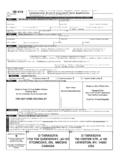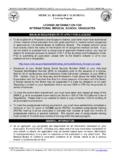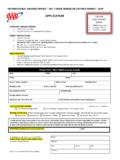Transcription of DOCSTOR-#486021-v1-Key Aspects of IP License …
1 2003 Donald M. Cameron, Rowena Borenstein KEY Aspects OF IP License AGREEMENTS Donald M. Cameron Rowena Borenstein 2003 Donald M. Cameron, Rowena Borenstein TABLE OF CONTENTS 1. Defining Intellectual Property Rights .. 1 (a) 1 (b) Trade-marks .. 2 (c) 3 (d) Soft IP Rights .. 4 2. Skeleton of a License 6 (a) Identification of the Parties .. 6 (b) Recitals .. 7 (c) Definitions .. 7 (d) License Grant .. 7 (e) 8 (f) Obligations of the Parties .. 8 (g) Term and Termination .. 8 (h) Conflict 8 (i) Other Common Clauses.
2 8 3. Grant of Rights .. 9 (a) Degrees of Exclusivity .. 9 (b) Sublicenses .. 10 (c) Scope of 10 (d) Implied Rights and other 12 4. Negotiating the Appropriate 13 (a) Royalties and License Fees .. 13 (b) Negotiating a Reasonable Royalty .. 14 (c) Most Favoured Nations Clause .. 15 (d) Basis for Royalty 15 (e) Minimums and Maximums .. 16 (f) Other 17 (g) Reports and Audit .. 17 5. Obligations of the Parties .. 18 (a) Disclosure and Assistance .. 18 (b) Exclusivity .. 18 (c) Enforcement of Intellectual Property Rights.
3 18 (d) Trade-mark 19 (e) Covenant to 20 6. Improvements, Enhancements and Modifications .. 21 (a) Licensor Improvements .. 21 Key Aspects of IP License Agreements 2 (b) Licensee Improvements .. 22 (c) Specific Licensee Customizations .. 22 7. Common Clauses .. 23 (a) Definition of Confidential 23 (b) Treatment of Confidential Information .. 24 (c) Representations and Warranties .. 25 (d) Disclaimers and Limitations of 26 (e) Infringement Indemnities .. 27 (f) Product Liability Indemnities and 28 (g) Insurance.
4 28 (h) Assignment Restrictions .. 29 8. Conflict 30 (a) Escalation .. 30 (b) Mediation and 30 (c) 31 9. Contract Termination and Renewal ..32 (a) Term, Expiration and Renewal .. 32 (b) Right to Terminate .. 32 (c) Effects of Termination .. 33 10. Enforceability .. 35 (a) Patent Licenses and Competition Concerns .. 35 (b) Restrictive 35 (c) Boiler 35 2003 Donald M. Cameron, Rowena Borenstein KEY Aspects OF IP License AGREEMENTS 1. Defining Intellectual Property Rights Intellectual property rights are intangible rights.
5 Unlike other personal property rights, they cannot be touched, or seen. For example, a copy of a book is a personal asset that is easily viewed and identified. Copyright does not prevent you from reading the book, or giving your copy of the book to another person. But the copyright does protect the expression of the words and ideas in the book, and it is that expression that is protected, not the physical copy of the book itself. In order to properly draft and negotiate License agreements, it is important to understand the nature of the intellectual property rights being licensed.
6 Different intellectual property rights will require different language in the grant of the License agreement . This is particularly true when multimedia products, which may incorporate several different types of intellectual property rights, are being licensed. The nature of the intellectual property right being licensed may also affect other provisions of the agreement , such as the length of term of the agreement . Most intellectual property rights are created by statute; they exist as a result of legislation which both defines and limits the scope of protection afforded to the intellectual property right.
7 They may be territorial in nature ( , a patent is only valid and enforceable in the ), or international ( , copyright in a book authored by a Canadian will be valid in all countries that are parties to the Berne Convention). They may be time-limited ( a Canadian patent is currently valid for a period of 20 years from the date the application for the patent was filed) or perpetual, subject to conditions (as long as a trade-mark is used in a manner that doesn t render it generic, the trade-mark right will continue to exist). Two general classes of intellectual property rights exist: so-called hard intellectual property rights (including patents, trade-marks and copyright) and soft intellectual property rights (including confidential information, trade secrets and know-how).
8 (a) Patents A patent gives the owner the exclusive right to manufacture, use and sell the invention claimed in the patent, and the ability to prevent others from doing the same. Of all of the intellectual property rights, patents grant the most exclusivity and the greatest amount of protection in respect of the patented invention. A patent will protect the ideas embodied in the claimed invention, and not just the expression of it. Even if you independently develop the same invention on your own, without any knowledge of the patent, you can still be barred from making, using or selling your invention until the patent that claims it has expired.
9 Key Aspects of IP License Agreements 2 Because of the breadth of exclusivity afforded to patent holders, patents are more difficult to obtain than other forms of intellectual property rights. A Canadian patent must be issued by the Canadian Intellectual Property Office. In order to be issued a patent, the invention must meet all four of the following requirements: (i) Patentable Subject Matter: any new and useful art, process, machine, manufacture or composition of matter, or improvement, can be the subject of a patent. Scientific principles, mathematical equations and other like inventions are not patentable subject matter.
10 As a result, in Canada, computer software programs that are purely algorithmic expressions may not be patented; however, some patents have been obtained on inventions where the software component is combined with some other non-algorithmic invention. (ii) Novelty: the invention must not have been disclosed in a manner such that that it had become available to the public prior to the filing date of the application (if the disclosure was by a third party), or prior to one year before the filing date of the application (if the disclosure was by the inventor). (iii) Non-Obviousness: the invention must reflect some amount of inventive ingenuity; in other words, it must not be obvious to a skilled professional in the art, having regard to all of the other information and prior art available to him or her.







